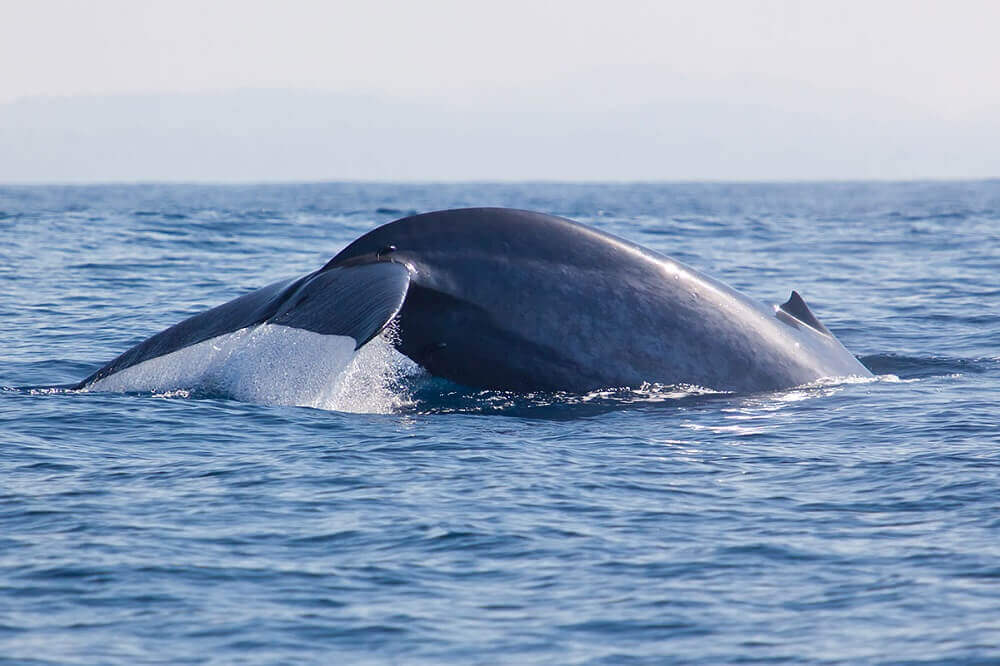
Blue whales, at the top of the food chain, play a significant role in the health of the environment. Scientifically known as Balaenoptera musculus, blue whales weigh as much as 33 elephants, have a heart the size of a car, and are full-size basketball court long. So you can say that they are heavier and larger than the biggest dinosaur ever existed. And these animals are so loud that their calls reach over 180 decibels, which is even higher than the sound of a jet engine. And that’s not all, even a whistle can be heard for a hundred miles. Blue whales live in colder waters during summer and migrate to warmer waters in winters to keep themselves comfortable. Also, blue whales cannot breathe underwater and have to come to the top to get fresh air. It’s really a shame that these magnanimous creatures are on the brink of extinction. As of now, only 10,000 to 25,000 blue whales remain in the world. The number may seem huge to common people, but it is too few compared to the huge world we live in, where 70% surface is water. So why are blue whales endangered? And what threats do they face today? We’ll find out in this article. So stay tuned!
Why Are Blue Whales Endangered? What Threats Do They Face Today?
-
Whaling:
Whaling, which is the killing and hunting of whales, is one of the major causes behind blue whales being endangered. People have always tried to hunt whales, but the speed and weight of these mighty mammals made it almost impossible for humans to catch. But in the 1900s, the hunters devised new tools and weapons and hunted thousands of whales every year. The primary reason behind whaling was business. People needed whale oil to make lamps, candles, soap, and margarine. Its other parts were used for food and fertilizers.
There was a time when these huge creatures were almost whaled into extinction, which made the International Whaling Commission take strict actions against it. In 1966, the commission made whaling illegal and the Endangered Species Convention Act listed the blue whale as endangered. Now, whaling isn’t considered a major threat to whales, but there are several other threats faced why these mammals today, which we have discussed below.
-
Climate Change:
Climate change is one of the biggest reasons behind the near extinction of whales. As the weather is getting warmer, the number of krill, their main food, is also decreasing. Even ocean acidification is impacting krill’s population.
Besides, frontal zones, which are considered important whale habitats are moving further south due to climate change. Frontal zones are boundaries between water masses, which bring large amounts of nutrients, stimulating the growth of phytoplankton, which goes on to support the population of whales’ prey species. With the frontal zones moving southward, whales have to migrate over 200 to 500 km more to reach the area, where they can build up reserves to sustain themselves for the entire year. These longer migrations deplete their energy and even reduce the duration of the feeding season.
-
Pollution:
As of now, pollution is the biggest threat to the existence of whales. Noise pollution by boats and drilling of gas and oil make it impossible for whales to communicate with other whales. You all must be knowing that whales make loud noises for communicating, but the anthropogenic noise makes it hard to hear each other.
Chemicals and plastics dumped by humans are also making life hell for blue whales. Blue whales consume plastic and take in chemicals through the waters, which makes them sick and eventually kills them. Recently, news surfaced about a dead whale that had almost 1000 pounds of plastic in its stomach.
-
Bycatch:
Bycatch is another reason behind their near extinction. Blue whales often get hurt by getting tangled up in fish lines thrown by humans to catch other fish. One such area is the Gulf of Corcovado, a feeding area of blue whales, which also happen to be home to salmon farms and are used extensively by fisheries. This causes multiple threats to the whale, such as vessel strikes, marine debris, and bycatch. World Wildlife has started using satellite tags to determine the routes used by whales. This will prevent the interaction between salmon farms and whales.
-
Entanglement:
As mentioned above, entanglement also causes immense harm to blue whales. The whales are entangled in fishing gear, either by becoming anchored or by swimming off with the gear attached. Blue whales get entangled in several types of gears, such as gillnets, ports, and traps. And since they swim with the gear attached, they ultimately get tired, which compromises their feeding ability. Some even get severe injuries, which reduces their reproductive success and even death in some cases.
-
Vessel Strikes:
Blue whales are often injured and even killed when they are hit inadvertently by boats or vessels. This risk is much higher in coastal areas, with heavy ship traffic. In 2007, three whales in California died after being hit by boats.
So these were the top reasons why blue whales are endangered. It’s worth noting that environmentalists are doing their best to conserve whatever a little number of blue whales are left today. So we hope the numbers of blue whales increase soon. What conservation methods would you suggest for saving the blue whales from extinction? Let us know by commenting below.
You May Also Like To Read:
List Of Endangered Species 2019
